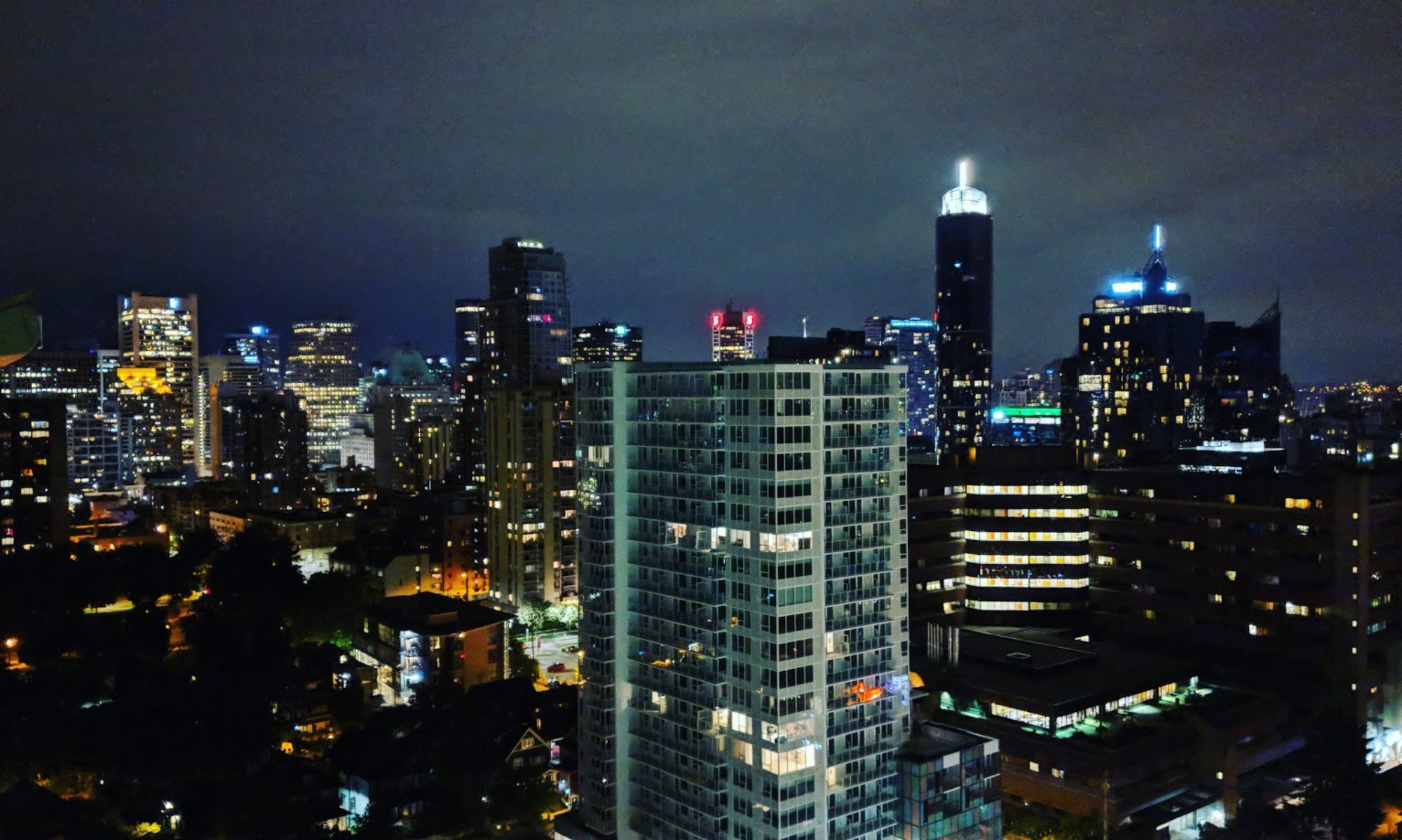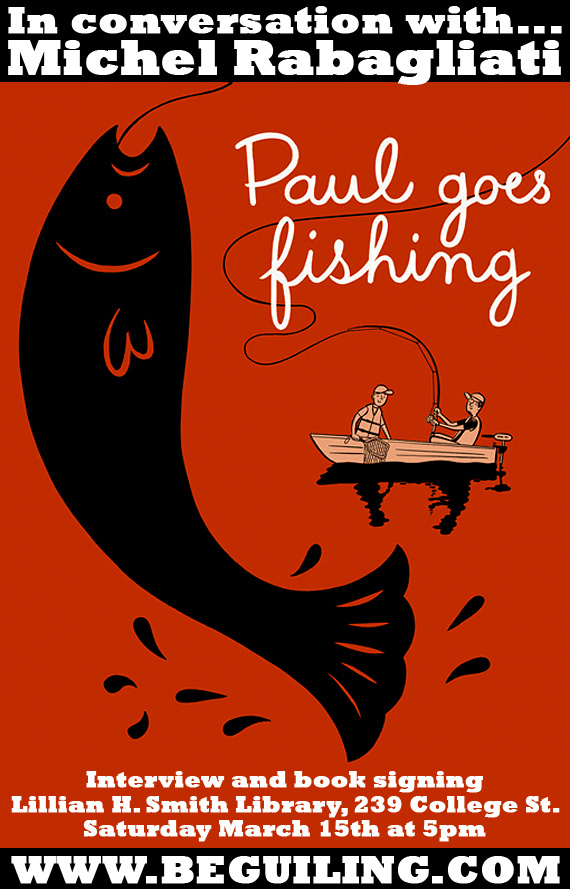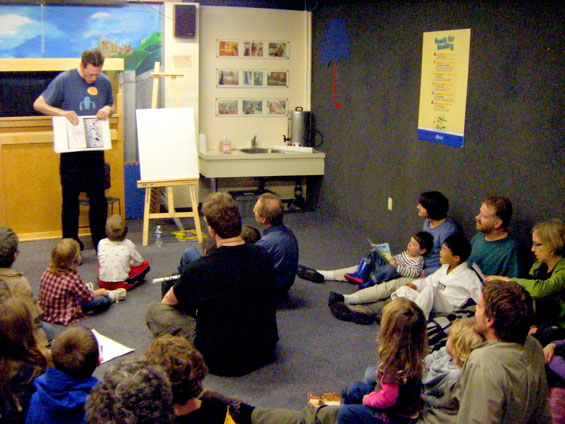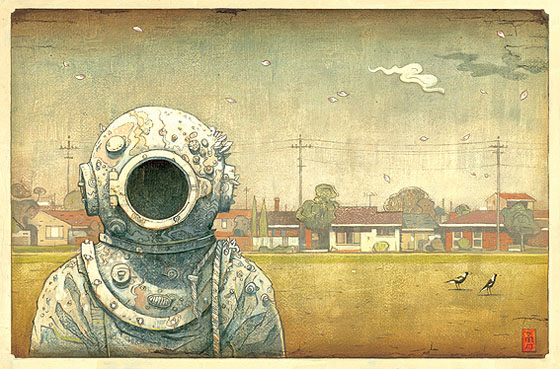This past weekend a new Japanese pop-cultural centre opened in San Francisco, and it sounds pretty awesome. It’s called New People and it’s… well it’s kind of a Japan-style mall. It’s got a gift shop with manga and artbooks and designer toys and things, 4 different goth/loli-informed clothing stores including a North American outpost for hyper-popular label Baby The Stars Shine Bright, a movie theatre sponsored by Viz, a cafe (or two), and an art gallery. It sounds like a pretty amazing building actually.
To celebrate the opening of New People, they held a great big cultural festival called the “J-Pop Summit”, with bands and clothes and artists and presentations from Yoshitaka Amano (final fantasy), Yuichi Yokoyama (New Engineering), and the director of the live action 20th Century Boys movie, which I guess Viz announced they have the rights to now? At least they had an actor dressed up like “Friend” from the books, which is kind of amazing too.
Check out these event descriptions from [About.com], [Same Hat!], and [Anime Vice].
All in all, it sounds like a truly amazing event, and a step forward for the promotion of Japanese pop culture in North America. It also seemed really weird to me as well, here’s why:
I think I mentioned that this fall I was lucky enough to see a presentation on Otaku by Professor Kaichiro Morikawa, an expert on Otaku, Japanese culture, and the export of Japanese culture outside of Japan. One of the most interesting points in his lecture (and the whole thing was phenomenal) was that Otaku spaces are generally _closed_ spaces, hidden from the public eye, and that non-Otaku spaces are all about being clear and visible and open to the public. The manga, software, doujin, and toy stores in Japan have their windows blacked out, and popular clothing and mainstream culture stores have big glass windows inviting eyes inwards. Otaku are introverts, ashamed of their purchases, non-otaku are extroverts flashing their shopping bags with massive brand-name labels on them (this is both only part of his larger point, and a simplification, but still). Check this out:
 Animate Flagship, Manga/Anime/Character Goods Store, Ikebukuro.
Animate Flagship, Manga/Anime/Character Goods Store, Ikebukuro.
 Softmap Software store, Akihabara
Softmap Software store, Akihabara
 Lamtarra, Porn Store, Akihabara
Lamtarra, Porn Store, Akihabara
Now, conversely, check out the frontage on these fashionable flagship stores in Fashion-capital Harajuku.
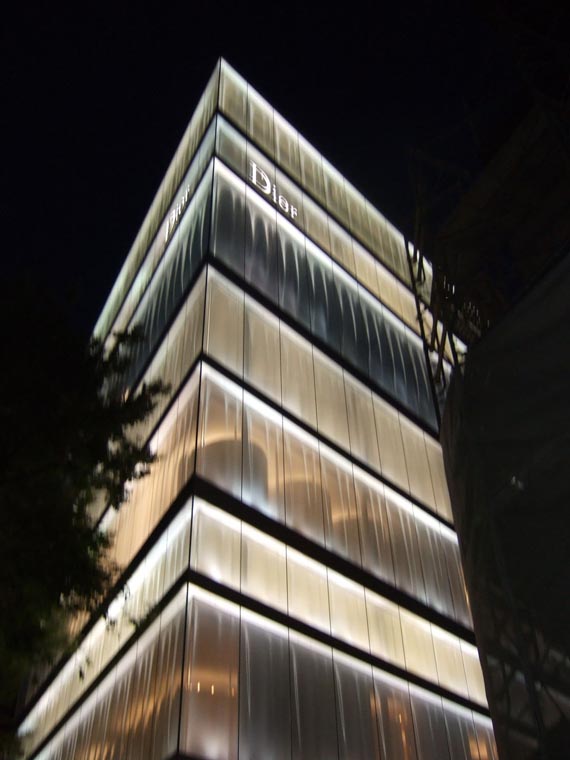
Christian Dior Flagship, Transparent Building
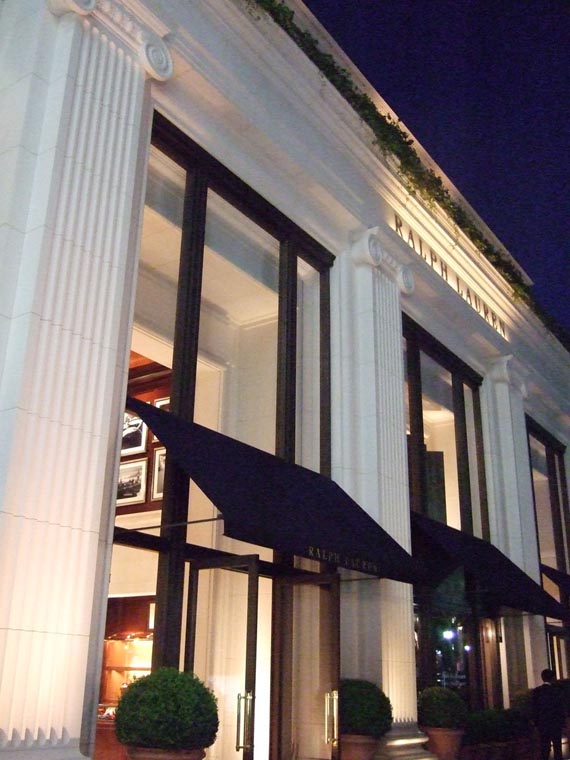
Ralph Lauren, 25ft high windows
 Louis Vuitton, giant glass windows with Takashi Murakami art done up in lights. Gorgeous.
Louis Vuitton, giant glass windows with Takashi Murakami art done up in lights. Gorgeous.
Can you see the difference?
Actually as a bit of an aside: Perhaps the most interesting thing here? Japanese Otaku have largely rejected much of LV ‘partner’ artist Takashi Murakami’s work, apparently. He appeals to the mainstream, to youth culture, and especially to other artists. But the hardcore nerds simply aren’t into his work or his ideals, so far as I can tell. There’s nothing moe about his work… Louis Vuitton’s great big transparent open-concept retail space (with multiple scultptures visible from the street…!) is directly in opposition to contemporary otaku retail and public spaces.
So I trust this point has been well illustrated?
Here’s what the NEW PEOPLE building looks like.

It doesn’t look like an Otaku space at all, not even a little. I mean, it’s GORGEOUS, it looks like cutting-edge Japanese fashion retail design. It reminds me a lot of the Harajuku H&M flagship actually, lemmie see if I can find a picture of it.
The scale of these two buildings is really, really different btw. The New People building is probably about as tall as the top lit part of that H&M building (called ‘the ice cube building’ btw) in the middle. But you see what I mean about that right, where each floor is open to the street, for 30+ feet of transparent frontage? That was the thing that struck me when looking at the reports on the opening of New People–it doesn’t look like it’s a space for nerds… despite the fact that it is clearly intended to be a space for nerdish pursuits.
The first-floor of the New People building features New People: The Store, a sort of gift-shop of Japanese culture. Artbooks, manga, toys, shirts, paper goods, designer items, etc. The folks at Anime Vice did a great walk-through of the space, and apparently they allow embedding so spend 30 seconds or so watching this:
Here’s a still photo, in case it doesn’t embed correctly or you don’t like clicking things:

Again, it’s got a big open floor plan and it’s lovely and well-designed, but it’s laid out like a boutique clothing store, not something ‘otaku’. Check this out, here’s what a hardcore otaku shop looks like:

Animate, Ikebukuro
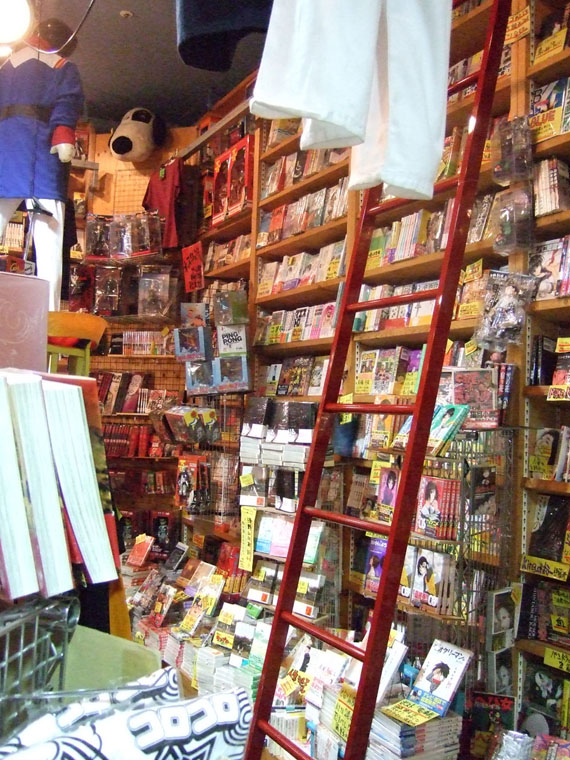 Village Vanguard, a pop culture chain store. Shown: Odaiba location.
Village Vanguard, a pop culture chain store. Shown: Odaiba location.
“So where the hell is he going with this?” you’re asking yourself. And to be honest, I’m not 100% sure. The whole thing is just leading to more questions for me, about intent, about the future of Japanese culture (and therefore manga…) in North America, about the future of retail. But I think what it all comes down to is the future, and the industry passing from a planning/regrouping phase into actively seeking “What’s Next?”.
I’m specifically curious what this means for Viz, whose CEO and parent-company are the primary investors/visionarries involved in this undertaking. Let’s face it, they’re so huge now that when you’re talking about the North American manga industry, you’re talking about Viz (publishers of Naruto, Bleach, and Pokemon, for those not in the know). For years I’ve been discussing whether or not “What’s Next?” in manga is going to be an aging demographic embracing more mature works… or if it’s just going to be 40 year old Naruto fans (mirroring the superhero comics industry). While they have continued to funnel new product into the all-consuming shonen/shojo machine, Viz seems to have clearly staked out the mature next steps, the seinen manga, the light novels, the more mature shoujo manga, the sci-fi fantasy novels. But they’re also importing larger parts of both Japanese youth culture and otaku culture. We’re getting more art books, we’re getting more Japanese movies, we’re getting more character goods. We’re getting online manga, for free, for audiences that could be entirely new to comics (or at the very least a part of the burgeoning literary/new mainstream graphic novel clique). Viz seems to be betting on a wider, wilder, more diverse manga industry (as part of a larger J-culture industry), and part of that is creating a cultural context for the material here in North America… that more than hardcore nerds are aware of. New People is clearly a massive leap in that direction.
But: NEW PEOPLE are deliberately eschewing the “otakuness” of otaku culture in an effort to present otaku culture to the mass market.
Viz, Shogakukan, all involved over there, they’re trying to create a mainstream cultural awareness of many different facets of Japanese culture, which (if successful) will make it much easier for them to import the thousands of more complicated, unique, challenging manga that they have access to through their Japanese parent companies. It’s a canny move from where I’m seeing, if it plays out right. To be honest, as a fan of complicated, unique, challenging manga I win no matter what.
It also looks like Viz just might be trying to move their fortunes out of the iron grip of the increasingly fickle thieves (“but I’m just sampling!”) that make up anime and manga fandom to… you know, ‘normal’ people. I just wonder when, or if, the hardcore nerds, the American Otaku, are going to revolt when their fandom is opened up to the general public… It already happens all the time on smaller scales, the fandom all watches pokemon, it gets too big, they hate pokemon and people who still like it are “Poketards”. Ditto Naruto, and it’s die-hard fans who are called “Narutards” by the otaku elite (you can tell they’re elite because they refer to anime with North American releases by their Japanese names).
I wonder how long it’ll be before, much like Nintendo hardcore fans (called “core gamers” in the lingo) before them, the American Otaku cry that the manga industry has abandoned them for the general public, where companies can make a fuckload of money for a tenth the effort of satisfying their often insane and frequently contradictory desires…?
Or has that editorial already been written?
Anyway, maybe it won’t go tits-up after all, no core-fans vs. casual-readers in Thunderdome.
Uniqlo is a popular Japanese clothing chain, it’s like the Japanese equivilent of The Gap (actually Uniqlo’s been eyeing buying The Gap for years now… anyway). Uniqlo has been doing a series of radical partnerships for the last few years, putting manga characters and art, and anime, and video games, onto t-shirts. Inexpensive t-shirts too, that ‘normal’ people are expected to buy and wear. They call the whole thing “Mega Culture”.
MEGA CULTURE. Parappa + Uniqlo = greater than the sum of their parts. The blending of introvert and extrovert culture.
Uniqlo’s got the big glass-fronted stores & they’ve got otaku culture all wrapped-up in them, in their lovely boutique-style store layouts. And they’re making money hand-over-fist. When I was visiting Japan, the recently released slate of Shonen Sunday Anniversary shirts had made a debut, and the Harajuku Uniqlo was actually hosting a gallery exhibition and mangaka signing, VIP invite only. I did not get in (LAME) but I did get to observe the normals, the average hip man-and-woman off the street, prowling the same t-shirt racks as obvious otaku, both finding common ground in a bitch’n Gundam Anniversary T or distressed Urusei Yatsura LUM women’s longsleeve. MEGA CULTURE.
So maybe that’s what we’re heading towards… a more seamless blend of nostalgia, youth, and introvert culture with the mass market. Maybe there’ll be friction between the established fans and those trying to spread/exploit that fandom. James Cameron’s NEON GENESIS EVANGELION probably won’t be worse than this summer’s G.I. Joe movie (how could it be?). Maybe not, and video game t-shirts goth-loli affectations will fade. But with the opening of a three-floor, culturally oriented shopping centre by a Japanese-owned American publisher with 15 years of experience in importing Japanese culture, one thing is for certain: the game has definitely changed.
– Chris
